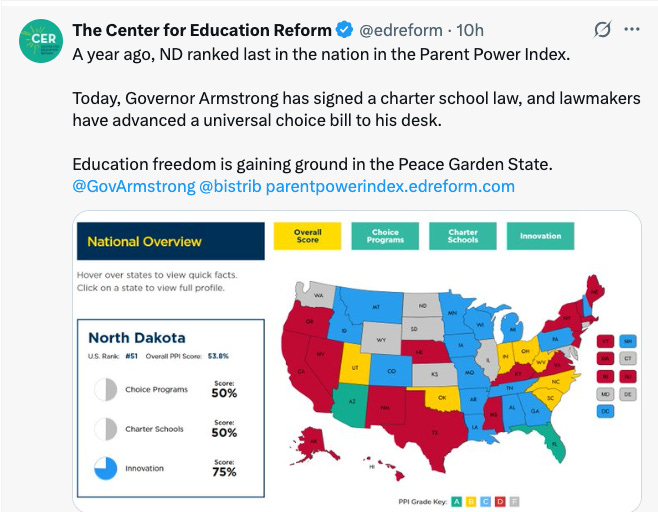Choice in Bloom
And a Papal Legacy
Choice is in bloom throughout the nation, building on the success of choice and charter efforts alike, not just over the past five years since Covid created an Ed Freedom wave, but after years of unwavering and relentless effort. Like most flowers, it is strong seeds that produce lasting beauty and hardiness year after year. The success of these and other efforts outlined below lies not just in those willing to fight today, but also in those who pushed when the idea was just germinating. Kudos to the pioneers, the roughriders, and today’s budding heroes.
It’s Big. So is Everything in Texas
After nearly two years of constant focus, Texas Governor Greg Abbott is poised to sign into law a program that will begin to help restore education excellence for hundreds of thousands of students. It’s been almost 35 years in the making—spurred by community and business leaders who couldn’t accept the poor condition of schools and who saw how school choice had begun to transform cities from Milwaukee to Cleveland as early as the 1990s.
Despite biennial efforts to make it happen and a growing advocate base, Texas just couldn’t get it done — until this crop of leaders. The most important takeaway this year—and one I’ve preached for decades having seen what succeeds and what fails—is that there must be people who wake up every morning—in the Governor’s mansion, the state house, and in communities—who have a fire in their belly and a relentless commitment to principle, not politics.
The sheer volume of name-calling and accusations of bad intentions would stop most people in their tracks. I’m so impressed by the Governor’s leadership—and of course, the Speaker, House leaders, and Senate leadership. Not to mention the parent advocates on the ground who stayed the course—pushing, pulling, and cajoling. They were all critical to this win. These are important lessons for all states that want to go big, too.
The Details
The details of the Texas bill are, of course, important. With a $1 billion budget, the new law will provide $10,000 to approximately 100,000 students over the next two years. And while that’s big, it’s a relatively small number compared to Texas’s 5.5 million students and pales in comparison to the $88 billion public school budget.
But like the highest-ranking choice states—Arizona, Florida, and Indiana among them —growth is bound to be slow but steady. When parents can access options, life is just better for their kids and families. To be sure, there will be lawsuits as that’s all the status quo seems to do these days, rather than focus on historically low proficiency scores.
Roughriders Join Charter Movement
It’s been a rough and rocky road through the badlands for charter school advocates, but with the election of a new Governor and two strong, resilient women lawmakers, a powerful headwind emerged to finally bring educational opportunities to the holdout state. Now, freedom, flexibility and commensurate funding await education entrepreneurs eager to personalize learning for students!
Come on Nebraska, South Dakota, and Vermont!
You’re the last states left without these vital public school options for kids.
Oh, and a modest ESA bill is also moving fast on the trail. Teddy Roosevelt would be proud of these roughriders!
🦖 A Dinosaur of a Decision
A Utah District Court has ruled that the state’s new Education Savings Account program—known as the “Utah Fits All” Scholarship—is unconstitutional. Judge Laura Scott, whose expertise is in real estate, wrongly determined that the program violates provisions of the Utah Constitution by allocating tax revenue earmarked for education to private and home-based education providers.
What she fails to understand is—as the late Justice Sandra Day O’Connor argued in the famous Zelman decision upholding the constitutionality of Ohio’s school choice programs—it is parents who are the conduit for decisions on where the tax dollars flow. As a result, the constitution is not violated when parents make direct their education funds to a non-public education options. Ironically, Scott attended the law school named for O’Connor at ASU.
The Utah case will be appealed to the state’s Supreme Court, and if it continues up the chain to the U.S. Supreme Cour,t it will be met with positive precedent as at least four major cases have upheld similar school choice laws. Yes, choice is constitutional, as Former Solicitor General Paul Clement and I wrote in advance of the Espinoza case. And the Court agreed.
It’s lawsuits like this that makes unions like the Utah Education Association—who filed the suit—as extinct as the dinosaurs that roamed the state. And it validates why parental freedom is so important.
Follow @Edreform on X for updates.
A Time of Hope and Easter Blessings
Pope Francis’ love of children, and his commitment to parents as their child’s first teacher should be remembered this week as the world mourns his passing. “Nothing is worth more than the life of a child,” he once said.
As the Thomas B. Fordham Foundation reported from his writings in 2016:
“Choice in education is a fundamental right of parents ‘of which no one may claim to deprive them’—meaning the state must not deny parents the right to select their children’s educational path, be it public or private, regardless of their financial means.
“Francis calls upon the state to provide educational opportunities for all families, but he emphasizes that ‘parents themselves enjoy the right to freely choose the kind of education—accessible and of good quality—which they wish to give their children in accordance with their convictions’” (paragraph eighty-four).
Even those who may have disagreed with his teachings—or who worship in different ways—recognize his deep compassion for the poor, for children, and for equal opportunity. These are values that should forever guide us.
Let His light shine on Papa Francesco and all for whom he prayed.
Wishing you and yours peace - Jeanne





